Exploring Sandpaper Bird Perches: Health and Comfort Benefits
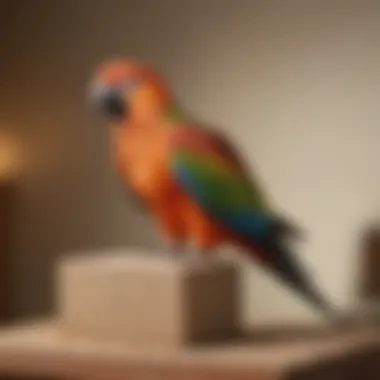
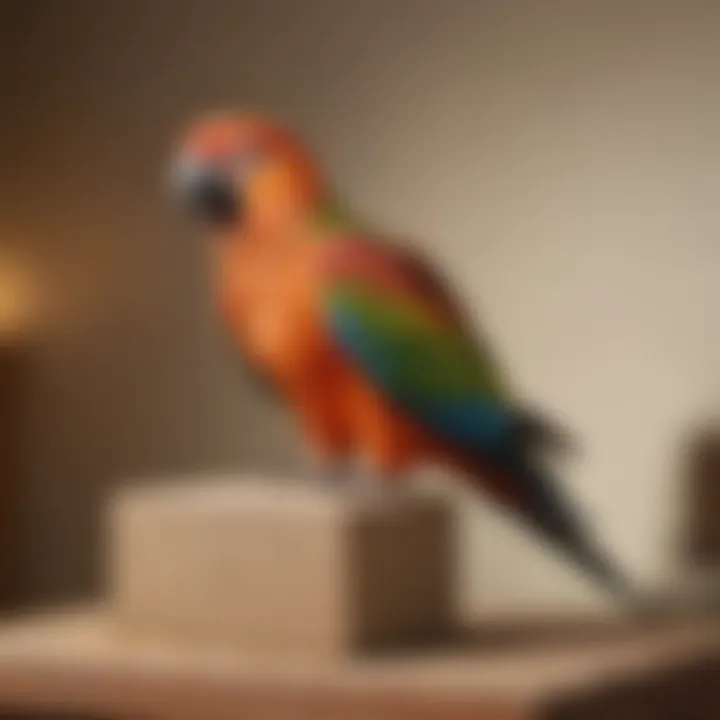
Intro
Birds are wonderful companions, bringing joy and vibrancy into homes. Their health and comfort are paramount for any pet owner. In this context, the choice of perches becomes crucial. Sandpaper bird perches are gaining attention for their potential benefits. This article will navigate through various aspects of these perches, illustrating their role in promoting avian health. We will discuss their advantages and disadvantages, how to use them properly, and alternative options that can also enhance your bird's well-being.
Understanding Your Pet
Understanding your pet bird is essential to ensuring they thrive in your care. Different bird species exhibit unique behavior patterns and have distinct needs. Knowing these nuances can lead to better choices for their habitat.
Pet Behavior Basics
Birds are social creatures. They thrive on interaction and stimulation. Understanding their behaviors, like preening, vocalizing, and foraging, aids owners in meeting their needs effectively. This understanding helps in selecting relevant accessories, such as sandpaper perches, that can promote their physical and mental health.
Common Breed Characteristics
Each breed comes with its own temperaments. For instance, budgies are often more playful, while cockatiels may exhibit signs of being more reserved. Recognizing these traits allows pet owners to cater to their specific needs, ensuring a healthy and enriching living environment.
Species-Specific Needs
Species-specific requirements vary significantly. Parrots need substantial space and climbing features, while finches require different perching surfaces suitable for their smaller feet. Sandpaper bird perches can provide a necessary texture for birds that need to maintain clean feet and actively exercise their toes.
Health and Wellness
Maintaining proper health is fundamental for any pet bird. Routine health checks and awareness of common ailments ensure a pet lives a long and healthy life.
Routine Vet Check-ups
Regular veterinarian visits are crucial. A veterinarian can provide tailored advice regarding your bird’s health and any specific needs related to their species and age. These check-ups can also help identify foot problems early, which sandpaper perches may prevent.
Vaccination Needs
Vaccinations may depend on your bird's type and environment. Birds can be susceptible to various diseases, many of which can be prevented through proper vaccination. Consult a vet to develop a vaccination schedule tailored to your bird.
Recognizing Signs of Illness
Understanding what is normal for your pet is essential. Changes in behavior, feed intake, or droppings may signal illness. Being vigilant allows you to seek medical assistance quickly.
Enrichment and Activities
Activities that stimulate a bird's mind and body are vital. The choice between indoor and outdoor activities can influence their happiness and health.
Indoor vs.
Outdoor Activities
Indoor activities can include providing various perches and toys. Sandpaper perches can be an avenue for foot exercise and maintenance. Outdoor time should be well-supervised, providing both sunlight and fresh air while ensuring safety against predators.
Interactive Toys and Games
Toys that encourage foraging or problem-solving can be beneficial. These activities keep your bird active and engaged, which positively influences their well-being.
Socialization Opportunities
Birds are social animals and enjoy interactions. Engaging them with other birds or family members can foster a more enjoyable living space.
Sandpaper perches support avian foot health, but they should only be one component of a well-rounded care routine.
Intro to Sandpaper Bird Perches
Sandpaper bird perches have gained attention in the realm of avian care. Understanding their role is crucial for pet owners. These perches offer a unique combination of benefits that can enhance a bird's health and comfort. In this section, we will delve into what sandpaper perches are and their intended purposes.
What are Sandpaper Bird Perches?
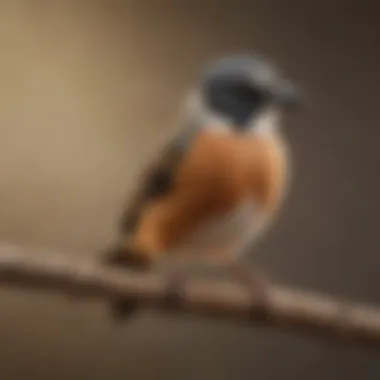
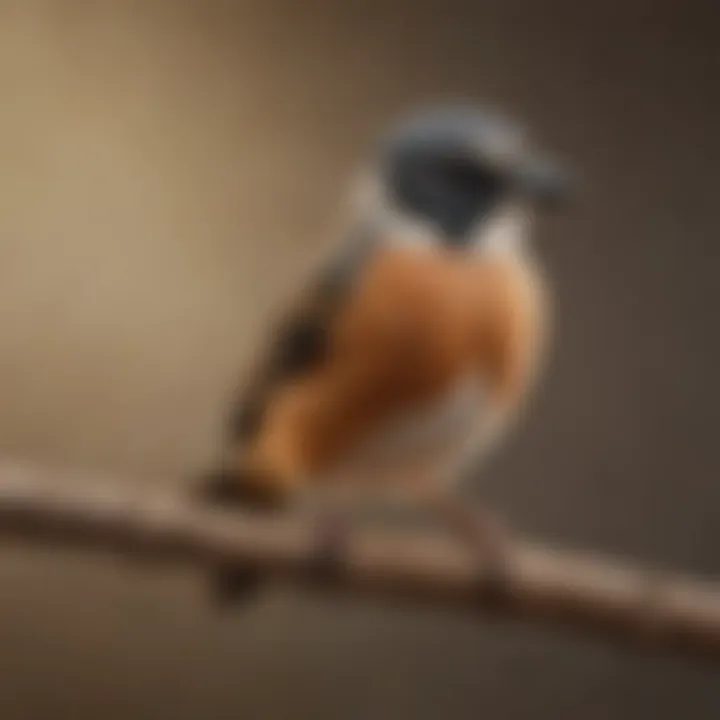
Sandpaper bird perches are specialized perches designed for birds. They are typically made from natural wood and feature a coating of sandpaper or a similar abrasive material. This design serves multiple functions. The texture ramps up grip, assisting birds in maintaining hold, especially during play or feeding.
These perches come in various sizes and shapes. The diversity allows owners to choose the perch that fits their pet bird's needs and cage environment. Plus, many come in different colors and patterns that add aesthetic appeal to the cage.
Purpose and Functionality of Sandpaper Perches
The main purpose of sandpaper perches is to support foot health in birds. As birds perch for extended periods, their feet are prone to developing various problems such as overgrown nails or foot sores.
Sandpaper perches help by naturally wearing down nails as birds perch or move around. This action reduces the need for frequent nail trimming, a process that many birds find stressful. Moreover, the rough surface encourages a more natural gripping behavior, which benefits the foot muscles and tendons.
In addition, these perches can serve as a source of enrichment. Birds are naturally active and curious, needing opportunities to engage with their environment. Sandpaper perches contribute to this interaction by providing a variable texture and surface for exploration. A well-chosen perch can effectively marry health benefits with behavioral stimulation, making it a valuable addition to any bird's habitat.
The incorporation of sandpaper bird perches into an avian environment encourages both foot health and mental stimulation, creating a more holistic approach to pet care.
Advantages of Sandpaper Bird Perches
The significance of sandpaper bird perches in avian health cannot be overstated. These perches offer unique benefits that go beyond mere aesthetic value. They play a critical role in maintaining the well-being of birds, particularly concerning foot health, comfort, and overall engagement in their environment. In this section, we will delve into the vital aspects of sandpaper bird perches, outlining their key advantages.
Foot Health and Nail Maintenance
One of the primary advantages of sandpaper bird perches is their remarkable contribution to foot health and nail upkeep. Unlike traditional wooden perches, sandpaper perches have a textured surface that encourages natural wear of a bird's nails. This is crucial because overgrown nails can lead to difficulties in movement and can even cause injury to the bird.
Regular use of these perches helps to keep nails at a manageable length. It is essential to ensure that the grit on the perch is appropriate for the specific type of bird. Too coarse a texture may cause discomfort, while too fine may not be effective at maintaining nails. Thus, selecting the right grit is a critical factor in promoting foot health.
Additionally, the textured surface encourages birds to grip and move around their cage, promoting exercise and active behavior. Foot conditions like bumblefoot can be minimized by providing adequate perching options, allowing birds to maintain healthy feet through regular activity.
Comfort and Grip for Birds
Comfort is another fundamental advantage provided by sandpaper perches. Birds are inclined to perch for extended periods, and their choice of perch can affect their overall comfort. Sandpaper perches often offer a better grip because of their textured surfaces. This grip is crucial, especially for smaller birds, as it helps them feel secure while resting.
Birds that feel secure are likely to engage in more natural behaviors, such as preening and playing. The comfort provided by these perches can lead to decreased stress levels, which is beneficial for their physical and mental health. A happy bird is a healthy bird, and ensuring comfort through the right perch type is an important consideration for any owner.
Stimulation and Engagement
Another significant benefit of sandpaper bird perches lies in their ability to stimulate and engage birds. Sandpaper surfaces can encourage more active exploration compared to smooth surfaces. Birds have a natural instinct to explore their environment, and these perches can facilitate that.
With varied textures and shapes available, birds can experience different challenges as they move and adjust their grip. This engagement not only promotes physical activity but also supports mental stimulation. Boredom in birds can lead to negative behaviors, such as feather plucking or excessive vocalization. Thus, having engaging perches helps in sustaining their interest and overall well-being.
In summary, sandpaper bird perches offer numerous advantages that cater directly to the health and comfort needs of birds. By promoting foot health, providing comfort, and fostering stimulation, these perches are a smart choice for pet owners committed to enhancing their avian companions' quality of life.
Disadvantages of Sandpaper Bird Perches
While sandpaper bird perches offer numerous advantages, it is crucial to recognize their potential downsides. Understanding these disadvantages informs pet owners about possible risks associated with their use, enabling informed decisions for the health and well-being of their birds. This section explores the main drawbacks of sandpaper perches, shedding light on their implications for avian care.
Potential Risks of Overuse
One significant concern with sandpaper bird perches is the risk associated with their overuse. If birds spend too much time on these perches, it can lead to excessive wear on their feet. Unlike natural surfaces, sandpaper is abrasive. Prolonged exposure can result in discomfort and stress. It's vital to provide variety in perching options. Incorporating different materials can help mitigate the risks. For instance, including natural wood perches can allow birds to rest their feet more comfortably.
Overuse can also create dependency, leading birds to avoid natural behaviors such as climbing and exploring their cage.
This limits their overall physical activity, which is essential for their health. To prevent these problems, owners should monitor the time birds spend on sandpaper perches and be attentive to any signs of distress.
Skin and Foot Issues
The skin and foot health of birds can also be jeopardized by sandpaper perches. Sandpaper can create micro-abrasions on a bird's feet, resulting in irritation or potential infections. Birds may develop calluses due to constant abrasion, which is not always beneficial. In extreme cases, if the skin becomes too compromised, it can lead to painful conditions. Pet owners need to be vigilant about observing their birds for any signs of discomfort or injury.
Providing a mix of perch types—such as those with softer textures—can help minimize these risks and promote better foot health. Regular examinations of your bird's feet are essential. It allows for timely intervention should any issues arise.
Cost and Availability
Finally, while many people view sandpaper perches as a standard product, they can come with both cost and availability concerns. Quality sandpaper perches are not always easy to find in local pet stores. This situation can lead to price inflation in some areas, with owners paying more for appropriate options. Furthermore, lower-quality options may not last long, leading to more frequent replacements, which can become expensive over time.
When deciding on sandpaper perches, it is essential to assess the overall value. Consider both the upfront cost and the long-term investment in the health of your bird. Researching various suppliers and exploring online platforms may yield more affordable and high-quality options. Therefore, while sandpaper perches are accessible, understanding their cost implications ensures pet owners are well-equipped for avian care.
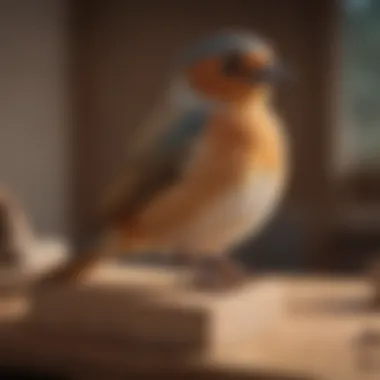
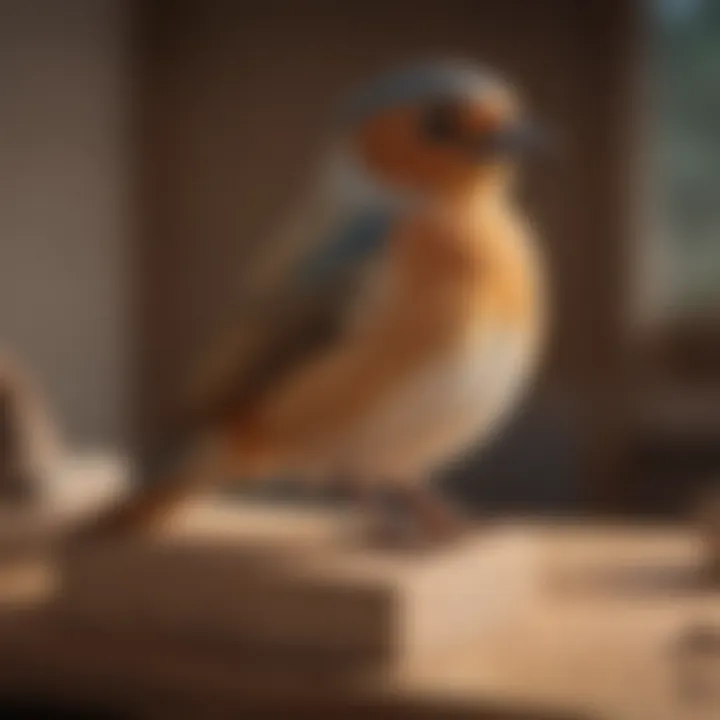
Selecting the Right Sandpaper Perch
Choosing the right sandpaper perch is crucial for maintaining the health and comfort of pet birds. The value of selecting a suitable perch cannot be overstated. A well-chosen sandpaper perch can enhance foot health, support nail maintenance, and improve overall well-being. It is vital for pet owners to consider various factors to ensure they provide an optimal living environment for their avian companions.
Material Quality and Durability
The material quality of sandpaper bird perches plays a significant role in their effectiveness. Quality materials tend to be more durable and provide better utility for birds. Sandpaper perches made from high-quality materials can resist wear and tear over time, ensuring that they remain functional.
Durability also means that these perches can withstand the daily activities of birds. A sturdy perch reduces the need for frequent replacements, which can save costs in the long term. When selecting sandpaper perches, consider brands known for their commitment to quality and sustainability. Always check for reviews from other bird owners, as these can provide insight into the longevity and performance of a specific perch.
Size and Shape Considerations
Perch size and shape are equally important elements to consider. The size should be appropriate for the bird species. Larger birds require wider perches, while smaller species benefit from thinner options. A perch that is too small can lead to discomfort and foot problems.
Moreover, the shape of the perch influences how birds perch themselves. Natural branches have varied shapes and diameters, offering more engagement and comfort. Sandpaper perches that mimic these natural characteristics can be more inviting and comfortable for birds. Adjustments in size and shape can provide the necessary support, fostering better health for the birds.
Texture and Grit Types
Texture and grit types are also vital in selecting a sandpaper perch. The grit on sandpaper varies, impacting how it performs for foot maintenance. Some birds benefit from a coarser texture that helps file down their nails effectively. Others may prefer a smoother finish for comfort, especially for extended periods of resting.
When exploring grit types, remember that too much roughness can lead to injuries, while too smooth may not provide enough maintenance. It is essential to strike a balance that suits the needs of your specific bird species.
A variety of textures may also be available within the same brand. This variety allows pet owners to experiment and find what best suits their bird. Always monitor the response of the bird to different perch textures to ensure maximum comfort and health.
In summary, careful consideration of material quality, size, shape, texture, and grit types can lead to informed decisions when selecting sandpaper bird perches.
By understanding these factors, pet owners can create a supportive and comfortable environment that helps to maintain the health of their feathered friends.
Proper Use of Sandpaper Bird Perches
Proper use of sandpaper bird perches is critical for maximizing their health benefits for pet birds. These perches can help maintain foot health and provide a comfortable resting spot. However, without appropriate guidelines and practices, the potential advantages might not be fully realized. Understanding how best to utilize these perches can lead to improved bird well-being and comfort.
Installation Guidelines
When installing sandpaper bird perches, several factors should be taken into consideration. First, the location within the cage matters. Ideal placement is where your bird spends most of its time. It allows easy access while encouraging natural behaviors. Next, ensure that the perch is securely attached. A well-fixed perch will not wobble, reducing risks of injuries. The height of the perch is also essential. Birds should feel safe and comfortable, so placing it at a height where they can quickly hop down or up is crucial.
Keep in mind the spacing between perches. If you have multiple perches, provide enough distance to prevent overcrowding. This allows your bird to select where to land without the risk of falling. Finally, continue to check that the surface remains clean and free of debris. Regular cleaning is essential to prevent the buildup of bacteria and dirt.
Rotating Perches Regularly
Rotating sandpaper perches periodically is a beneficial practice. Over time, different areas of the perch may wear down faster. By rotating them, you can distribute wear evenly, ensuring that one area does not become too smooth or too rough. This practice helps maintain the intended grit and texture essential for foot health.
Additionally, introducing variation in perch types and orientations can stimulate your bird’s curiosity. Birds thrive on change. It keeps them engaged and reduces boredom. Ultimately, rotating perches contributes to their mental and physical health.
Monitoring Bird Behavior
Observing your bird's behavior on sandpaper perches is vital in ensuring their well-being. Pay attention to how they interact with the perch. Look for signs of discomfort or disinterest. If a bird constantly avoids a certain perch, it may not be appropriate for their needs.
Significant changes in your bird’s routine might indicate issues that need addressing. For instance, if a normally active bird becomes lethargic, they could be experiencing foot pain. Regular monitoring allows early detection of potential problems, leading to timely interventions.
In summary, practicing proper use of sandpaper bird perches involves ensuring correct installation, regular rotations, and diligent behavior monitoring. These steps promote health and comfort, ensuring your feathered friend thrives.
"Choosing the right approach can enhance both the physical wellbeing and psychological health of your bird."
Alternatives to Sandpaper Bird Perches
When considering the best options for your pet bird, exploring alternatives to sandpaper bird perches becomes vital. While sandpaper perches offer certain benefits, they are not without their drawbacks. A range of alternative perch types exist, each presenting unique features that can cater to different bird species and their specific needs. Understanding these alternatives not only enhances your bird's comfort but also plays a significant role in their overall health and well-being.
Natural Wood Perches
Natural wood perches are a popular choice among bird owners. They mimic the bird's natural environment, providing a surface that feels comfortable and familiar. These perches are often crafted from untreated branches of various trees such as manzanita, willow, or fruit trees like apple and pear.
Benefits of natural wood perches include:
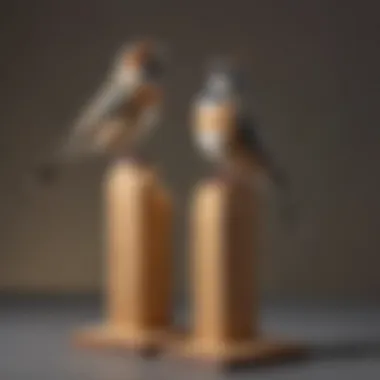
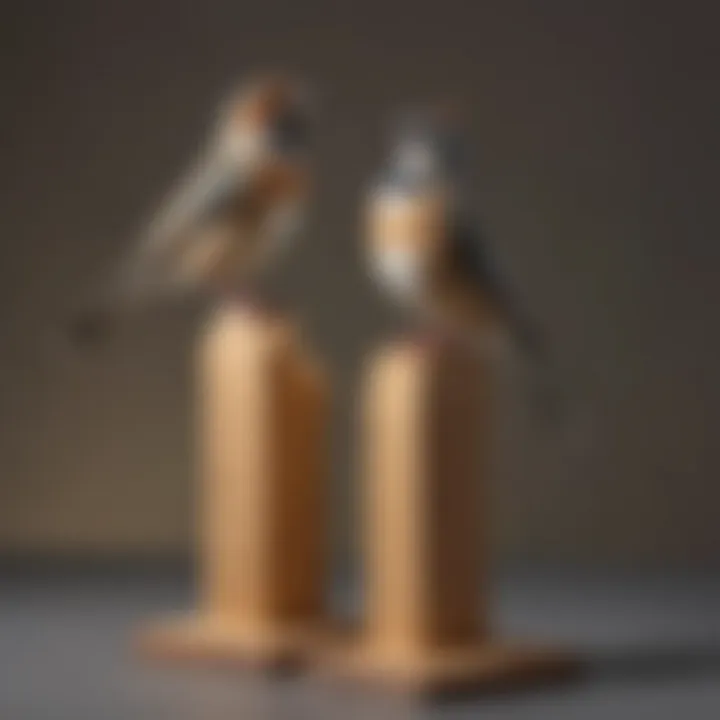
- Variety of Textures: The natural bark can help maintain foot health by providing a surface that can wear down a bird's nails naturally.
- Varied Diameters: Perches come in different sizes, allowing birds to grasp them comfortably, which is critical for their foot and leg muscles.
- Aesthetic Appeal: Their organic appearance adds a natural touch to the aviary.
However, it is essential to ensure that wood is free from pesticides and chemicals, as these can harm birds. Cleaning can also be more challenging than with synthetic materials.
Plastic and Rubber Perches
Plastic and rubber perches offer an alternative that is easy to clean and maintain. These perches are usually designed to be safe for birds and can come in various shapes and colors. Some benefits include:
- Durability: They are resistant to weathering and can last longer than other types of perches.
- Ease of Cleaning: Their non-porous surfaces mean they can be wiped down easily, minimizing the risk of bacterial growth.
- Variety of Shapes: Many plastic perches come in creative designs, which can help stimulate your pet's interest.
Despite these advantages, it is important to monitor your bird regularly. Birds may still require more natural texture to keep their feet healthy. Over-reliance on plastic can also result in foot problems in some cases.
Naturalistic Environments
Creating a naturalistic environment is another effective alternative for enhancing your bird's quality of life. This involves combining various elements, such as natural perches, plants, and stimulating accessories.
Consider the following aspects when designing a naturalistic habitat:
- Variety of Perches: Mix different types of perches, including both wood and rope, to cater to different needs.
- Foraging Opportunities: Incorporate toys and hiding spots that encourage natural foraging behaviors.
- Space for Movement: Ensure enough space for flight and exploration, reducing stress and promoting well-being.
Adding natural elements can encourage instinctual behavior, enriching your bird's life significantly. By diversifying the perching options and creating a lively habitat, pet owners can provide a more holistic care approach.
In summary, the selection of perch alternatives plays a crucial role in maintaining your bird’s health and happiness. Whether choosing natural wood, plastic, rubber perches, or creating a naturalistic environment, the key is to prioritize diversity and comfort.
The Role of Perches in Avian Enrichment
Bird perches play a vital role in the overall enrichment of avian environments. The choice of perches influences not only the physical well-being of birds but also their psychological health. Perches like sandpaper bird perches can enhance the living conditions for pet birds by fostering natural behaviors, which are crucial for their development and happiness.
Exploring Natural Behaviors
Birds in the wild engage in a variety of behaviors, such as climbing, preening, and exercising their feet. Understanding these natural behaviors is key to providing a suitable environment for pet birds. Sandpaper perches enable birds to perform essential activities that mimic their wild counterparts.
By using sandpaper perch, birds can naturally wear down their nails and maintain foot health. Over time, this can lead to a more comfortable and healthier foot structure. This is particularly true for domesticated birds that do not have the same opportunities for natural wear and tear. Moreover, these perches can stimulate curiosity through different textures, encouraging exploration and play.
Advantages of stimulating natural behaviors include:
- Improved health and morphology of feet
- Reduced stress levels from engaging in natural activities
- Encouragement of social interactions among birds kept together
Physical and Mental Stimulation
Physical activity is essential for birds to maintain their overall health. Sandpaper bird perches provide the necessary stimulation for foot exercise through climbing and perching activities. This exercise contributes to a healthy weight and reduces the risk of obesity and related health issues.
In addition to physical benefits, these perches also enhance mental stimulation. Birds are naturally inquisitive and require mental challenges to thrive. A variety of perch types can offer both challenge and novelty, preventing boredom. Birds that engage in exploratory behavior tend to be more active and show fewer signs of stress or anxiety.
Benefits of physical and mental stimulation from sandpaper perches include:
- Enhanced muscle tone and coordination
- Reduction in unwanted behaviors, such as feather plucking
- Increased interaction with owners or other companion birds
By recognizing the role of perches in providing enrichment, bird owners can create a more fulfilling environment. This results in content birds that are healthier both physically and mentally.
Finale
In this article, we explored the significant role of sandpaper bird perches in enhancing the health and comfort of pet birds. The characteristics of these perches offer both advantages and disadvantages, making them a topic of interest for many bird owners. It is essential to understand that while sandpaper perches can facilitate foot health and grip, improper usage could lead to adverse effects.
Summarizing Key Points
To summarize, the key points covered in this article about sandpaper bird perches include:
- Foot Health: Promotes healthy feet and nails through regular maintenance and natural wear.
- Comfort and Grip: Provides a secure place for birds to perch with its textured surface.
- Engagement: Offers stimulation by encouraging natural behaviors.
- Risks of Overuse: Potential for injury if used excessively without rotation.
- Cost Considerations: Availability and pricing can impact choice.
These points highlight the dual nature of sandpaper perches in avian care.
Final Thoughts on Sandpaper Perches
In closing, sandpaper bird perches present various benefits, but they also require careful consideration. Pet owners must take the time to monitor their birds and ensure that these perches are used correctly. Proper implementation involves rotating perches, tracking behavior, and considering the individual needs of each bird.
Choosing the right type and maintaining an optimal environment can significantly influence the overall well-being of your feathered friend. The thoughtful integration of sandpaper perches in your bird's habitat can lead to a healthier and more engaging life. As you ponder your choices, be sure to focus on the balance of health and comfort to provide the best care for your companion.
Always prioritize the unique needs of your pet bird when selecting perches to ensure both safety and comfort.







